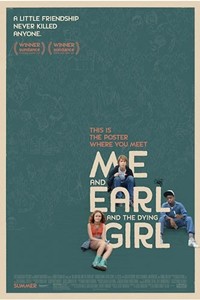
Artistry and expression are particular themes that carry significance for all three main characters, particularly Earl. Cyler, who has extensive experience as a musician, noted that music has been his coping mechanism. "Mostly I use music as my outlet for my emotions, both DJing and with the drums," he said, getting laughter from everyone when saying he just imagines the face of his brother on the drum set when he needs to let things out.
One of the major forms of expression in the film are the micro-budget films that Earl and Greg make together, mostly acting as parodies of famous arthouse efforts that Greg's dad has shown them over the years. Mann has personal experience from high school, noting that "we made parodies of films like The Matrix and Saw, but ours was called Spoon instead. The pure joy of discovering your tastes in things when you're that age is thrilling." Cooke said Rachel had the same things with "scissors and her dad's books," a component that grows stronger over the second half of the film.
Film obviously plays a vital role, as Gomez-Rejon demonstrates. His direction is heavily influenced by his own experiences growing up and learning the craft while having others appreciate the art. "Films were my calling," he said. "I understand Greg and Earl making their films and, even when Greg gives Rachel a film that they made, it means a lot. He wasn't planning to but she breaks down and it happens, and it's a turning point." Mann said that they shot most of those small films in one day on a guerrilla-style adventure.
The thing that shines most in the film, though, is its sincerity. "I saw the honesty of the characters, and that kept me going," Mann said. When considering Greg especially, that becomes apparent. Cooke says, "You're not being forced to like these characters...Greg is the most selfish teenager you could meet but you can connect to him. This awful thing is happening to this girl and all he can think about it is how it is affecting him. That's terrible, yet we can all connect to that."
Despite the film being a low-budget entry by most Hollywood standards, it doesn't particularly feel like one. Gomez-Rejon explains, "We weren't conscious of the budget, and we didn't want to make it look small-budget. With those constraints, a lot of creative solutions can come out of them. You don't want to rush the movie. The worst thing to do, in my eyes, is to rush actors." Cooke commented that, after indies like The Signal and The Quiet Ones, this was "one of the biggest budget movies I've ever worked on."
Yet that low budget created some incredibly authentic elements. "[The screenwriter and novelist] Jesse's actual childhood home was Greg's house, and his bedroom was Greg's in the story, so it gave the film a lived-in quality," Mann explained. Same with the films within the films, as Gomez-Rejon ensured, since they could not be too well-produced or else they would be unrealistic."
The film's personality does not just come from its humor or lived-in nature, but also its grave tackle of cancer. Personal experiences run rampant with the cast: Cyler's grandmother and her husband passed, Mann's four grandparents died of cancer at a young age for him, and Cooke met with a young girl at a children's hospital who had undergone chemotherapy and a bone marrow transplant. "It's hard to meet someone like her and not feel like the biggest phony ever," Cooke said.
Gomez-Rejon has experience with stories handling cancer since he shot the broadcast pilot for Red Band Society, a Fox series that premiered last fall. He wanted the film to follow the stages of cancer, but also handle an issue that most were unfamiliar with: "The colored wigs used were important because it's such a dramatic change for teenage girls, and important for girls battling cancer, as the doctors told us. Artists like Katy Perry and Nicki Minaj using those wigs nowadays as a statement of power and individuality is helping and the details feel honest in the narrative." That's surprising considering the attention paid to those celebrities, but he makes a point that rings true for many girls who lose their hair during chemotherapy.
The highlight of the film for everyone involved? "Anything with Molly Shannon," Mann says. "She was a therapist. You went anywhere and she was a step ahead, ready to play," Cooke proclaimed. Cyler's favorite moment with her was "a night time scene with [her] where Thomas started beatboxing and I started singing really weird songs. It was a bonding moment between three very weird people."
As for the reaction at Sundance, none of them expected the acclaim that they got, even if they felt they were making something unique. Cooke said: "This script was the most special script I ever read. After shooting, I felt that we had something really amazing. I'm naturally pessimistic to protect myself, but I couldn't help to feel it." Cyler put it succinctly: "This was my first time hearing about Sundance and knowing what it was. This film was also my first so it's like a first child: you don't know what's going to come out of it. So we said, 'let's try not to make it a bum.' And he turned into a nice engineer."
Me and Earl and the Dying Girl is one of the year's best films.
It opens in Phoenix on June 19th.









